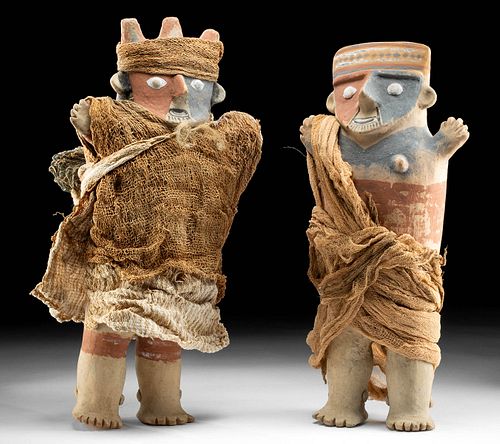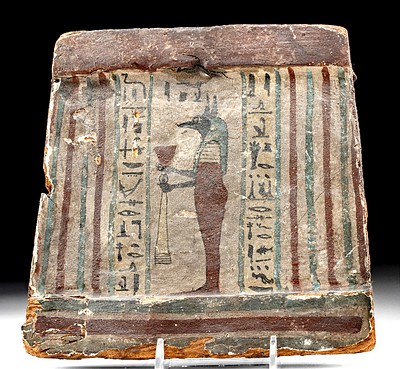Rare Chancay Polychrome Figures Male, Female TL'd
Lot 99a
About Seller
Artemis Gallery
686 S Taylor Ave, Ste 106
Louisville, CO 80027
United States
Selling antiquities, ancient and ethnographic art online since 1993, Artemis Gallery specializes in Classical Antiquities (Egyptian, Greek, Roman, Near Eastern), Asian, Pre-Columbian, African / Tribal / Oceanographic art. Our extensive inventory includes pottery, stone, metal, wood, glass and textil...Read more
Categories
Estimate:
$13,000 - $19,500
Absentee vs Live bid
Two ways to bid:
- Leave a max absentee bid and the platform will bid on your behalf up to your maximum bid during the live auction.
- Bid live during the auction and your bids will be submitted real-time to the auctioneer.
Bid Increments
| Price | Bid Increment |
|---|---|
| $0 | $25 |
| $300 | $50 |
| $1,000 | $100 |
| $2,000 | $250 |
| $5,000 | $500 |
| $10,000 | $1,000 |
| $20,000 | $2,500 |
| $50,000 | $5,000 |
| $100,000 | $10,000 |
| $200,000 | $20,000 |
About Auction
By Artemis Gallery
Aug 26, 2021
Set Reminder
2021-08-26 10:00:00
2021-08-26 10:00:00
America/New_York
Bidsquare
Bidsquare : Fine Antiquities | Asian | Ethnographic Art
https://www.bidsquare.com/auctions/artemis-gallery/fine-antiquities-asian-ethnographic-art-7366
Features classical antiquities, ancient and ethnographic art from cultures encompassing the globe. Egyptian, Greek, Roman, Etruscan, Near Eastern, Asian, Pre-Columbian, Native American, African / Tribal, Oceanic, Spanish Colonial, Russian, Fine / Visual Arts, so much more! Artemis Gallery info@artemisgallery.com
Features classical antiquities, ancient and ethnographic art from cultures encompassing the globe. Egyptian, Greek, Roman, Etruscan, Near Eastern, Asian, Pre-Columbian, Native American, African / Tribal, Oceanic, Spanish Colonial, Russian, Fine / Visual Arts, so much more! Artemis Gallery info@artemisgallery.com
- Lot Description
Pre-Columbian, North Coast Peru, Chancay, ca. 800 to 1200 CE. An impressive and rare pair of terracotta cuchimilco figures - a male and a female - wrapped in woven textiles of orange, tan, peach, and cream hues. Both figures stand atop delineated legs and feature a welcoming pose with stubby arms outstretched and their heads pointed skyward. Their faces are comprised of almond-shaped eyes, protruding pinched noses, and petite ears. Carrying a satchel containing a dehydrated husk of maize and corn kernels, the male displays an erect phallus which projects from beneath his garments. The female exhibits pointed breasts and incised genitalia surrounded by a triangle that highlights her pubic area. Characteristically left unglazed, pigments of burnt sienna, black, grey, peach, and white decorate the white slip surface of both fascinating figures, emphasizing the whites of their eyes and teeth and also representing face and body paints. An intricately decorated headband of geometric motifs wraps around the flat head of the female figure. The male is embellished with three spikes that cap his head, acting as an elaborate coiffure or headdress, swaddled with a band of cloth. Size: 8.75" W x 17.5" H (22.2 cm x 44.4 cm)
The Chancay people were exceptional ceramic and textile artisans, and archaeologists have often found cuchimilcos in the tombs of Chancay nobility. Some scholars believe that their outstretched hands were intended to absorb negative energy. Chancay artisans created ceramics that are quite distinctive in form and decoration - finely painted and molded with specific decorative details carefully added by hand as we see in this example.
Like these two examples, Cuchimilco figures are often found in pairs of male and female, indicating the importance of divine duality. Archeologists posit that these charming pottery figures were intended to ward off bad spirits or energies.
This piece has been tested using thermoluminescence (TL) analysis and has been found to be ancient and of the period stated. A full report will accompany purchase.
This piece has been searched against the Art Loss Register database and has been cleared. The Art Loss Register maintains the world’s largest database of stolen art, collectibles, and antiques.
Provenance: private Honolulu, Hawaii, USA collection; ex-Patricia Catlett collection, Albuquerque, New Mexico, USA, acquired in 1971; ex-Leon Buki, Kramer Arte Primitivo, Buenos Aires, Argentina
All items legal to buy/sell under U.S. Statute covering cultural patrimony Code 2600, CHAPTER 14, and are guaranteed to be as described or your money back.
A Certificate of Authenticity will accompany all winning bids.
PLEASE NOTE: Due to recent increases of shipments being seized by Australian & German customs (even for items with pre-UNESCO provenance), we will no longer ship most antiquities and ancient Chinese art to Australia & Germany. For categories of items that are acceptable to ship to Australia or Germany, please contact us directly or work with your local customs brokerage firm.
Display stands not described as included/custom in the item description are for photography purposes only and will not be included with the item upon shipping.
#163216TL hole on proper right foot of male and another on proper left foot of female. Resurfacing on legs of female. Expected surface wear as shown with nicks and abrasions, commensurate with age. Fraying to fabric garments in areas. Otherwise, intact and excellent with lovely earthen deposits and great remaining pigments.Condition
- Shipping Info
-
All shipping is handled in-house for your convenience. Your invoice from Artemis Gallery will include shipping calculation instructions. If in doubt, please inquire BEFORE bidding for estimated shipping costs for individual items.
-
- Buyer's Premium



 EUR
EUR CAD
CAD AUD
AUD GBP
GBP MXN
MXN HKD
HKD CNY
CNY MYR
MYR SEK
SEK SGD
SGD CHF
CHF THB
THB














